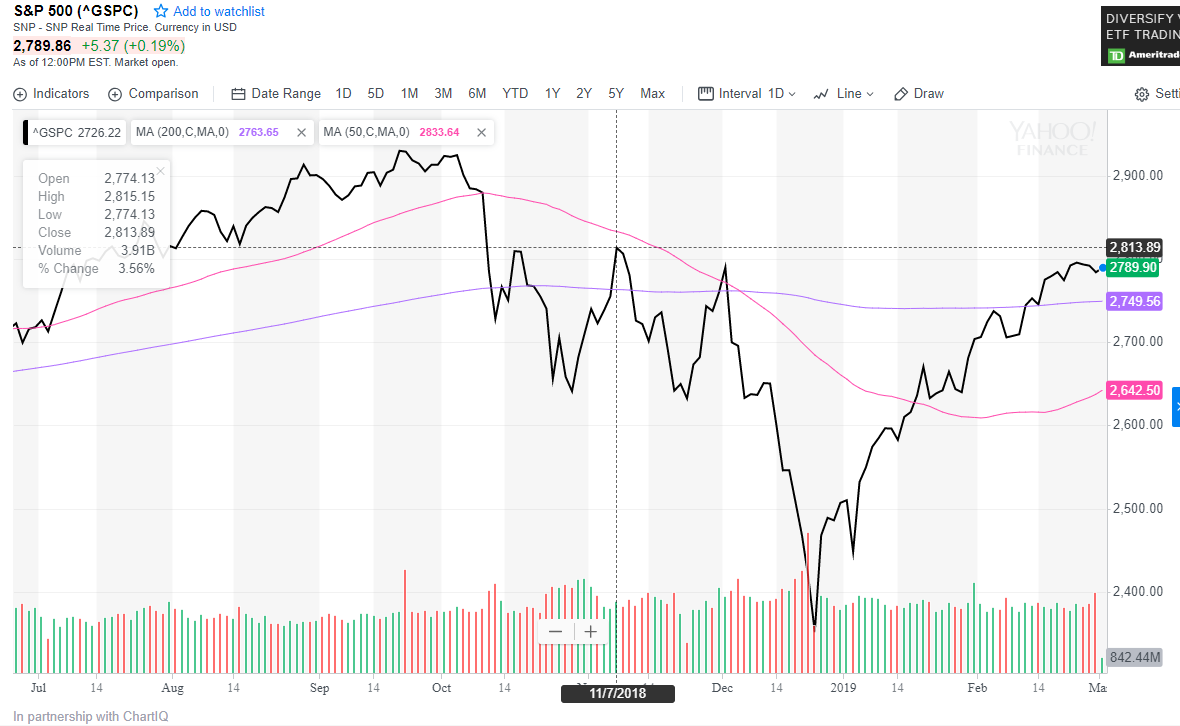February was another strong month for the stock market, continuing the advances from January, with the Dow and NASDAQ ending the month with positive returns in excess of 3%, and the S&P 500 just shy of 3%. Small cap and technology stocks continued to outperform the broad market (S&P 500), and bonds ended the month fractionally higher.
This month’s market pulse will focus on the technical attributes of the stock market, demonstrating significant repair since the current cycle low of December 24, 2018.
Moving averages (MA) help us observe trends in the market, with the 50-day MA widely being held as a near term trend line, while the 200-day MA being held as a longer-term trend line. A MA is simply the average of past days closing prices – a smoothing out the day-to-day volatility and the directional trend of a specific index. At TWG we keep an eye on both the price comparison of an index to the MA as well as the direction (upward or downward trend) of the MA itself. The picture above reflects the S&P 500 overlaid with the 50-day MA (pink) and 200-day MA (purple).
As you can see the S&P eclipsed the 50-day MA on January 16th, and the 200-day MA on February 12th. After being in decline since October 9, 2018, the direction of 50-day MA turned upward on February 1st. The 200-day MA, being of longer duration, peaked on October 22nd and began to gradually sag, slightly trending downward until January 15th. The fact that both the 50-and 200-day MA are now trending higher, along with the S&P firmly trading above the 200-day MA is technically constructive, indicating both the near term and longer term trends have turned positive.
We typically observe that after approaching a specific moving average, an index tends to trend around that MA until there is a decisive break out in one direction or another. That the S&P soared above the 50-day MA and upward to the 200-day MA in such a swift advance, coupled with the fact that the S&P has decidedly broken out, and maintained a price ABOVE the 200-day MA is a positive technical sign.
However, another important component of technical analysis is the index eclipsing previous cycle highs (resistance), notably the closest levels of resistance of 2790 (12/3), 2813 (11/7) and 2809 (10/17). This resistance needs to be breached to the upside for the technical analysis to suggest the market can potentially make new all-time highs. Last reached on September 21, 2018 at 2929, the S&P closed out the month of February at 2795, and closing in on the important 2813 level.
We will continue to observe how the market plays out around these technical areas of resistance, and whether the S&P can firmly hold above the 2800 level. Or whether this level will continue to be an area of overhead resistance that has been in place since mid-October. If the S&P decidedly rally’s past the 2813 level, then we would anticipate a run to the 2900 range, further increasing the values of your portfolios.
During the month of February we have systematically allocated most of the remaining cash into equities, and are just about fully invested, riding the trend higher. We will continue to monitor the markets and events that may potentially impact overall sentiment. We feel encouraged that the technical repair discussed above will allow the market to maintain its current elevated levels or even continue higher towards new all-time highs.
Contact us with questions anytime. We welcome questions and feedback.
Because of the information on this blog are based on my personal opinions and experience, it should not be considered professional financial investment advice. No financial decisions should be made based off this article without consulting with your financial advisor first.

